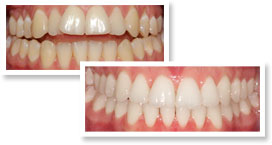For All Ages
Orthodontics for Children
While there is no exact age for children to begin orthodontic treatment, the American Association of Orthodontists (AAO) recommends visiting the orthodontist around age seven.
By this age, most children have a mix of baby teeth and adult teeth. This sometimes makes it possible for the orthodontist to diagnose and treat a developing tooth and/or jaw problem sooner and without surgery and/or tooth extractions.
Early treatment (Phase-One) may allow your orthodontist to:
- Improve the self-esteem of your child's view of their own smile
- Decrease the risk of trauma to protrusive (sticking out) upper front teeth
- Guide eruption of the remaining adult teeth (decrease risk of tooth impaction and subsequent surgery)
- Regulate the width/length of the upper jaw to decrease the likelihood that future surgery would be needed to obtain an ideal outcome
- Create more space for crowded teeth
- Avoid the need for permanent tooth extractions later in life
- Decrease risk of developing a permanent skeletal asymmetry and possible jaw joint (TMD) issues in the future
- Improve some types of underbites (lower jaw is ahead of upper jaw)
- Improve anterior crossbites (upper front teeth are stuck behind lower front teeth) where permanent damage to lower front teeth is occurring
- Improve a thumb sucking habit and its resulting minor speech problems
- Decrease overall treatment time of Phase-Two (full upper and lower braces with straightening and bite correction of all adult teeth) once the majority of baby teeth fall out
For parents, it's not always easy to know if your child may need orthodontic treatment.
Here are a few things to look for that may mean your child needs to see an orthodontist:
- Early or late loss of baby teeth (your child should typically start losing teeth around age five, and will normally have all permanent teeth around age 13)
- Decreased self-esteem attributed to the child's view of their own smile
- Protruding teeth where the top teeth and the bottom teeth extend away from each other (underbite or overbite)
- Teeth that don't come together in a normal manner or even at all (open bite)
- Shifting of the jaw when your child opens or closes his or her mouth (crossbites)
- Crowded front teeth around age seven or eight
- A narrow (V-shape) upper jaw
- Your child continues sucking his or her thumb after age five
- Minor speech impediments with an open bite
All children with baby teeth still present are clinically evaluated by Dr. Foley at the initial consultation where parental concerns are also addressed. At the conclusion of the consultation, a determination of the best time to start orthodontic treatment is made by the doctor. In some cases, there is a medical/dental benefit to early treatment. In these cases, children receiving Phase-One (early) orthodontic treatment could help to decrease or eliminate a developing dental/skeletal problem to provide quicker, less invasive Phase-Two (full upper and lower braces with straightening and bite correction of all adult teeth) treatment time once the majority of their adult teeth are erupted. Receiving early orthodontic treatment as a child may help prevent problems from becoming only correctable with surgery and/or extraction of teeth in the future.
If there is nothing to be gained by early treatment, in most cases, treatment will be recommended when the majority of adult teeth have erupted. In the meantime, the child is invited to become a member of our very own 'Little Phillies Club'! Here, they are seen for free dental/skeletal observations periodically to determine the best time to start treatment. Members receive a free prize each visit and are enrolled in all of our office contests.
Please contact our practice to schedule an appointment for an orthodontic evaluation. Early (Phase-One) treatment now may allow for a more a healthy, beautiful smile for the future.
Orthodontics for Teens
Braces, retainers, and everything else that you want to know about orthodontics!
You've just heard the three words that every teen dreads: “YOU NEED BRACES!”
Braces! What now?
Don't worry! Braces aren't nearly as scary as you may think. In fact, braces today come in a variety of styles, materials, and colors, making life with braces much easier, more comfortable, and even more stylish than in the past.
How long will I have to wear braces?
The amount of time it takes to treat your smile with braces depends on three key factors:
- Early (Phase-One) treatment — In some cases, early treatment allow orthodontists to monitor and influence specific jaw growth/adult tooth eruption problems. This way, once the majority of your adult teeth have erupted and you are ready for full upper and lower braces (Phase-Two), your overall braces experience will be easier since problems were addressed early on. Not everybody receives early orthodontic treatment; in most cases it is recommended that a patient wait to receive treatment until most of your adult teeth have come in. In the meantime, you would enter into dental/skeletal observation for regular checkups.
- What needs correction — The amount of treatment needed to correct a problem will determine how long the process takes. Different patients react to treatments differently. While it may take one patient only 12 months to complete treatment, it may take another patient 24 months. Treatment times can vary depending on how quickly your body responds and how much work is needed to give you the show-stopping smile you expect.
- YOU! — Your willingness to use the appliances your orthodontist gives you plays a major role in the length of time it takes to complete your treatment. Always remember to take care of your braces and appliances; this truly will help make your treatment shorter!
Braces Your Way!
Our practice offers a variety of braces, types and styles, to choose from. Some common options include:
- Clear (ceramic) braces
- Clear aligners
- Traditional metal braces
Orthodontic braces are a big part of life for many people your age. While braces may have had a bad reputation in the past, today's braces make it easy to look good and feel good! Please contact our practice to schedule your next orthodontic checkup.
Orthodontics for Adults
Orthodontic treatment is no longer just for teens. In fact, the American Association of Orthodontists (AAO) states that one in five orthodontic patients is over the age of 21. Many adults are choosing to receive treatment because they want to feel better about their appearance. Adults everywhere are taking advantage of the opportunity to receive orthodontic care, and now you can too.
Common reasons why adults consider orthodontic treatment:
- A bad bite (malocclusion), causing teeth to fit together incorrectly (overbite, underbite, deepbite, open bite)
- Teeth are crowded or spaced apart
- Desire for a more confident smile
Treatment options for adults
For many adults, the thought of having metal braces is enough to discourage them from receiving treatment. However, today's orthodontic treatment options offer a variety of braces and appliances that are comfortable, aesthetic, and customized to meet your needs. Types of braces include:
- Clear (ceramic) braces
- Clear aligners
- Traditional metal braces
The difference between adult orthodontics and orthodontics for children and teens:
The main difference to remember when treating adults or children and teens, is that in younger patients the jawbones are still developing. For adults, these bones have stopped growing, which may mean the possibility of surgical orthodontics to align the jawbones for an ideal outcome. It may also mean the possibility of a slower rate of tooth movement than in children. Other differences include:
- Gum or bone loss (recession and periodontal disease) — Adults are more likely than children to experience gum recession or even bone loss, possibly due to periodontal disease. Therefore, it is extremely important that adults regularly see their dentist for regular cleanings and checkups, at least once every six months, throughout orthodontic treatment.
- Worn or missing teeth — Over time teeth can become worn down and shift into different positions that can only be corrected with orthodontic care. Missing teeth can cause other teeth to shift and tilt, creating a bad bite.
- Incomplete orthodontic treatment as a teen — Many adults received some orthodontic treatment as a child or teen, but never completed their treatment. As an adult, they choose to complete their orthodontic treatment to achieve the healthy, beautiful, functional smile they always wanted.
We ensure at Foley Orthodontics that you will receive the highest quality orthodontic treatment. Our practice also recognizes that adults and children have different needs. We will strive to meet your needs with the utmost understanding.
Why should you consider orthodontic treatment?
- A beautiful, straight smile builds confidence — Orthodontic treatment can help boost your self-confidence, giving you a better quality of life and the freedom to smile without holding back!
- Mouths left untreated can get worse — Not receiving orthodontic treatment when it's needed may create long-term tooth/jaw dental/medical problems. This may lead to more invasive required treatment with greater morbidity and financial cost down the road.
To learn more about the benefits of adult orthodontics please contact our practice to schedule an appointment. We understand that you have a busy schedule, and we will work with you to make sure each office visit is as convenient as possible.
-
Testimonials
"I am very grateful for the opportunity of meeting Dr. Foley and the experience I have had with him."
~ Vanessa R. Read Vanessa's Story -
Testimonials
"My experience with Dr. Foley is unforgettable."
~ Janairis P. Read Janairis’ Story -
Testimonials
"I would not trade him for any other orthodontist. He's the best!!"
~ Mother of Devon O. Read Devon’s Mother’s Story
Get Started
It’s Easy. It’s Free
Fill these out before your first appointment.









 Website Powered by Sesame 24-7™
Website Powered by Sesame 24-7™